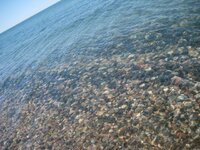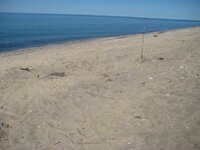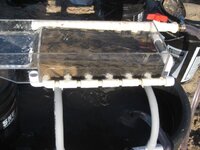Capt Nemo
Bronze Member
Went back up to Lake Superior with the model 4 fluid bed for two days. I decided to run the model 4 as there's less plumbing to clog. I ran 6 buckets from 4 PM to sundown that night, and another 18 the next day. Came home with 2 gallons of cons.
Here's the beach.

The old black sand layer that was there last year was washed out and/or pushed up to the log/grass line. Rocks were scattered everywhere. Just below the grass line, there's lots of coarse black mixed with the blond, but nothing to dig. Below the waterline you can see the sorting of the cobble. It might be good to try dredging these.

Here's the operation, and after. Can you spot 24 buckets of tailings?


The 55 Watt solar panel system brought the battery up from 12.2V to a peak of 13.4V during a break, but averaged 12.6V while running for the day. The bilge pump runs about 36 Watts.
I'm glad I ran the model 4 this time as preclassification was needed due to the amount of junk in the sand. I had to run a full cleanout every 3 buckets for the amount of junk clogging the pump and jets. I classified at window screen, but it would still let roots and algae through. This time I remembered the tool!



And here's what I was digging. The black sand was in a layer about 3/4" to 2" thick. I dug around the grass as much as possible, and only uprooted 2 shoots in all the buckets filled. Here's the bed after 1 bucket.


While panning the blonde sand out of the cons, a family stopped by to watch what I was doing. I taught their 6 year old girl how to pan beach sand with my 10", and she hit a great panfull of raw material from behind a log! I bottled 30 flakes out of that pan for her to take home! I think she's hooked!
A real nice fist sized agate was found right where I was going into the lake to get water from. The finder was a local who also stopped to talk. She let me in on a couple of thick BS slicks that were 6-12" thick or better. She also gave me a better map of the area and she marked the good spots that are public land. Another semi-local stopped by and said I was the first he's seen hitting the beaches for gold. He's mainly a MD'er, but knew what I meant when I said miller table. Also met a few iron miners from Marquette, and I asked about running the crushed tacconite mill tailings for possible gold. Sounds like a no-go there, but maybe possible.
And so it's time to start miller tabeling the cons. Gold pic's to follow!
Here's the beach.

The old black sand layer that was there last year was washed out and/or pushed up to the log/grass line. Rocks were scattered everywhere. Just below the grass line, there's lots of coarse black mixed with the blond, but nothing to dig. Below the waterline you can see the sorting of the cobble. It might be good to try dredging these.

Here's the operation, and after. Can you spot 24 buckets of tailings?


The 55 Watt solar panel system brought the battery up from 12.2V to a peak of 13.4V during a break, but averaged 12.6V while running for the day. The bilge pump runs about 36 Watts.
I'm glad I ran the model 4 this time as preclassification was needed due to the amount of junk in the sand. I had to run a full cleanout every 3 buckets for the amount of junk clogging the pump and jets. I classified at window screen, but it would still let roots and algae through. This time I remembered the tool!



And here's what I was digging. The black sand was in a layer about 3/4" to 2" thick. I dug around the grass as much as possible, and only uprooted 2 shoots in all the buckets filled. Here's the bed after 1 bucket.


While panning the blonde sand out of the cons, a family stopped by to watch what I was doing. I taught their 6 year old girl how to pan beach sand with my 10", and she hit a great panfull of raw material from behind a log! I bottled 30 flakes out of that pan for her to take home! I think she's hooked!
A real nice fist sized agate was found right where I was going into the lake to get water from. The finder was a local who also stopped to talk. She let me in on a couple of thick BS slicks that were 6-12" thick or better. She also gave me a better map of the area and she marked the good spots that are public land. Another semi-local stopped by and said I was the first he's seen hitting the beaches for gold. He's mainly a MD'er, but knew what I meant when I said miller table. Also met a few iron miners from Marquette, and I asked about running the crushed tacconite mill tailings for possible gold. Sounds like a no-go there, but maybe possible.
And so it's time to start miller tabeling the cons. Gold pic's to follow!
Upvote
0










